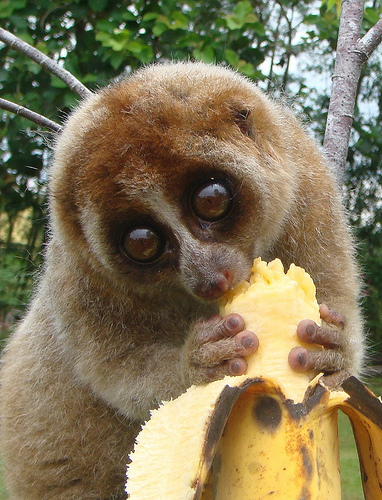Adult slow lorises range in size from 21 to 38 cm (8.3 to 15 in), depending on the species, and weigh up to 2 kg (4.4 lb). The tail is a mere stump, and the forelimbs and hindlimbs are of roughly equal length. The short, thick fur can have a variety of colours, but most common is reddish-grey with white undertones. They have well developed opposable thumbs, which they use to grasp and hold branches, and a very flexible back. A specialized arrangement of blood vessels in the wrists and ankles (rete mirabile) prevents muscle cramps and allows the slow loris to cling for extremely long periods of time. They have a grooming claw on one foot. Their eyes are large and point forward and also upward, and color vision is minimal. Their ears are small and nearly hidden in the fur. They are generally built stronger than the slender lorises, and possess a strong sense of smell.
Slow lorises can produce a toxin which they mix with their saliva to use as protection against enemies. The toxin is similar to the allergen in cat dander. Mothers will lick this toxin onto their offspring before leaving them to search for food. The toxin is produced by glands on the insides of their elbows. The lorises suck it into their mouths and deliver it when they bite or lick or kiss. Loris bites cause a painful swelling, but the toxin is mild and not fatal. Cases of human death have been due to anaphylactic shock. If the toxin does not deter a predator, the slow loris will often drop from the branch to the ground and roll into a protective ball.
Just look at it. You want one, don't lie.




